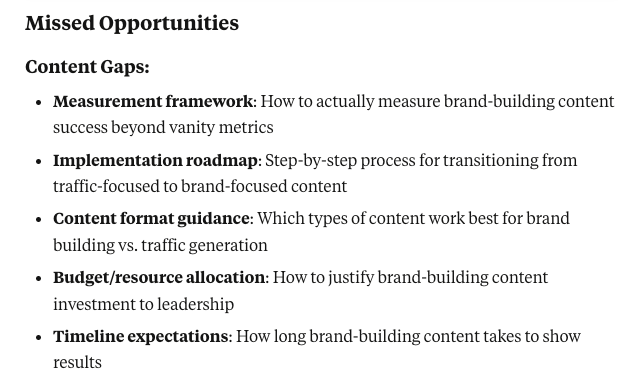- Top of the Funnel
- Posts
- 6 actually useful AI writing prompts
6 actually useful AI writing prompts
+ one advanced workflow for cutting down editing times 👀
Marketing ideas for marketers who hate boring
The best marketing ideas come from marketers who live it.
That’s what this newsletter delivers.
The Marketing Millennials is a look inside what’s working right now for other marketers. No theory. No fluff. Just real insights and ideas you can actually use—from marketers who’ve been there, done that, and are sharing the playbook.
Every newsletter is written by Daniel Murray, a marketer obsessed with what goes into great marketing. Expect fresh takes, hot topics, and the kind of stuff you’ll want to steal for your next campaign.
Because marketing shouldn’t feel like guesswork. And you shouldn’t have to dig for the good stuff.
See folks saying we need to be using AI to create better content, faster and think:
“Cool but… how?”
I gotcha 🍻
Here are six simple AI prompts that will help you create better content…
And one advanced workflow that will predict what edits your clients are going to suggest before you send over the first draft 👀
Let’s dive right in…
🔎 Find real-world examples with ChatGPT
The best content doesn’t tell – it shows.
Problem is, coming up with real-life examples to pack into your articles ain’t always easy…
But ChatGPT makes it easier 👀
Next time you’re writing an article, follow Kate Starr’s lead and ask ChatGPT to give you some examples of what you’re looking for.
This doesn’t have to be complicated. The prompt Kate used to find the example that illustrates her point in this introduction she wrote for Backlinko:

Was simply:
“Provide me with 5 e-commerce brands that have great web design.”
Then she used some follow-up prompts — like “suggest five more I probably haven't heard of” — to find lesser-known examples.
🚀 Improve any piece of content
Okay, this one’s really cool…
Paste this prompt into your fave LLM along with a link to any article.
Then it will evaluate the piece based on the content best practices Andy Crestodina and the Orbit Media team have developed after:
Publishing and promoting 600+ articles
Surveying 10,000+ bloggers
Working with 1000+ clients on content production
You are a content marketing strategist. Your task is to evaluate the quality of the article linked to below. Assess how well it follows best practices for engaging, persuasive and comprehensive content. Use the criteria below to score the article.
Create a table with the following categories as rows: Strong intro or opening hook, visuals at every scroll depth, use of evidence and examples, formatting (headers, bullets, bold/italic, short paras), internal links to related content, expert quotes or contributor input, personal angle or opinion, topical completeness (no major gaps), relevance to target audience (intent, tone, expertise level)
For each category row, add three columns:
The visual score (color code each category 🟥 = 1–2 (Weak), 🟧 = 3 (Moderate) 🟩 = 4–5 (Strong)
A short comment explaining the score
Suggestions for improvement.
Next find missed opportunities: List anything clearly missing or weak. Suggest specific ways to fix it: what’s missing, what to add, example fix (copy/layout)
Finally, wrap up with a quick summary: Overall strength: high / moderate / low, best feature, biggest opportunity to improve, recommended action: republish as-is / update / rewrite / remove
[insert link to article]
To test this out, I ran this prompt through Claude with last week’s TOFU deep dive on Devin Reed’s tips for creating brand-building content.
And IMHO the ideas in the ‘Missed Opportunities’ section it gave me are five solid ideas for standalone pieces of content 👀

That’s a pretty good return on the 43 seconds it took to run that prompt…
🧠 Get smarter questions for your SME interviews
Kiran Shahid runs through this AI workflow before every SME interview:
Instead of coming up with 5 generic questions I’d send to anyone, I give Claude:
✨ The working title
✨ My H2s or article structure
✨ A short description of who I’m interviewing and their role
Then I prompt:
"I'm working on this piece for [company name] on [topic]. Attached is an outline of the article.
What questions can I ask [SME name]? He/she/they... [background]. Give me questions for each section of the article."
Kiran says this has two big benefits:
I no longer have to shoehorn quotes into sections that don’t fit.
Plus, SMEs also get well-represented in your piece because they're not competing with five other experts answering the exact same generic prompts.
🏎️ Go from transcript to outline in seconds
Thanks to Kiran, you’ve got a great SME interview on your hands.
Now steal this prompt from Jess Cook to take it from messy transcript to A+ outline in seconds:
I had a XX-minute conversation with an internal subject matter expert on [topic]. Below is the transcript of that conversation. Using the information here, please give me a blog post outline of H1s, H2s, and H3s.
This outline should not flow chronologically from the conversation below. Instead, please take in all the information and give me the most logical outline based on the entirety of the information. This outline should include a section, where logical, about how [product] can help [audience] [solve problem].
🧐 Spot the flaws in your argument (before your editor does)
Here’s one of Rosanna Campbell’s fave ChatGPT prompts:
"Here's a summary of my thesis [Add in the argument you're currently making in your piece].
Pretend you're [industry expert] and pull it apart. Show me where I'm wrong, where I'm oversimplifying, and what I'm missing."
AI is surprisingly good at this. And it's a great way to get out of my own head and see my blind spots.
I end up with a more nuanced argument that's far more likely to appeal to an expert readership.
Bani Kaur does something similar:
I ask ChatGPT to analyze my writing for any logical reasoning gaps. 3 out of 5 times it points out things I've overlooked. For example, I sometimes skip an explanatory sentence to keep things "succinct". And I've learnt this because it’s been pointed out to me repeatedly by ChatGPT.
👶 Break down complex concepts
Struggling to wrap your head around a really technical concept you need to cover in an article?
Use Kat Boogaard’s prompt: “Explain [concept] to me like I'm in kindergarten."
Here’s how this one came in clutch for Kat:
I recently wrote an article about flowchart loops. As someone with very little (read: no) coding or programming knowledge, all of the existing research and resources I read on the topic made my head spin.
So, I asked ChatGPT to break it down for me. And surprisingly, it spit out a simple, real-world example that made me go, “Ohhh, so that's how it works!” Even better, I was also able to adapt and improve that example to use it in my final piece.
🤓 Expert mode: Become your clients’ favourite freelancer
Next time you’re making the edits a client has suggested to an article, follow Kiran Shahid’s lead and create a spreadsheet with four columns:
Column 1: Original line
Column 2: Client feedback
Column 3: My rewrite
Column 4: Type of edit (tone, clarity, too robotic, etc.)
Every time you respond to an edit from that client, add it to your spreadsheet.
Then feed your LLM of choice your first draft, your spreadsheet or edits, and a prompt like this one Kiran shared with me (shoutout Kiran 🫶):
[CLIENT] EditorBot: Precision Copy Editing for [CLIENT] Content
Purpose
This AI-powered copy editor is designed to align your writing with [CLIENT]’s editorial standards before submission. It ensures direct, actionable, and solution-oriented content that resonates with their audience.
# Editing Checklist
## Remove Redundant Introductions
[CLIENT] prefers getting straight to the point.
Avoid setting up the problem with general statements—start with the solution.
## Use Direct, Actionable Language
Replace vague phrases with specific actions.
Example:
❌ "How do you plan effectively? By using capacity planning, which includes..."
✅ "Capacity planning ensures your team is prepared. Key steps include..."
# Output Format
Each flagged issue will follow this structure:
1 - [Short Issue Description]
Location: [Paragraph Number]
Issue: [Brief explanation of what's wrong]
Suggestion: [Rewritten suggestion in [CLIENT]’s preferred style]
# Example:
1 - Improve Clarity and Directness
Location: Paragraph 2
Issue: "Last-minute scrambling and overloaded teams aren’t just frustrating—they’re avoidable." (Redundant introduction before the solution)
Suggestion: "Use workload forecasting tools to predict your team's future bandwidth and prevent last-minute scrambling."
# [CLIENT]-Optimized Copy Editing Process
Paste your draft into [CLIENT] EditorBot.
Receive a structured report listing all necessary changes.
Revise accordingly before submitting your content.
This ensures your articles match [CLIENT]’s expectations, reducing revision rounds and making your workflow more efficient.
Kiran says this “mimics the client’s voice + flags stuff they’d definitely nitpick”, which leads to:
Fewer Google Doc tears
Fewer round-3 revisions
More “that was nice” comments
🫵 What about you?
Pretty good prompts, right?
But I’m greedy for MORE!
Lemme know any AI prompts your swear by in TOFU, folks 👀
 | TOFU Community Manager |
Take the next step in your freelance business
MOFU Mastery gives freelancers, solopreneurs, and agency owners the tools, resources, and support they need to grow today—and stay ahead tomorrow.
Join MOFU today to get the full catalog of MOFU resources, trainings, and templates including:
Six-Figure Strategist
Break/through Bylines
The 360° Content Refresh Workflow
Advanced Keyword Research
The 5-Minute Proposal System
Agency & Freelancer Positioning
Plus, get access to weekly co-working sessions and a private peer network…
All for just $49/month 👀

